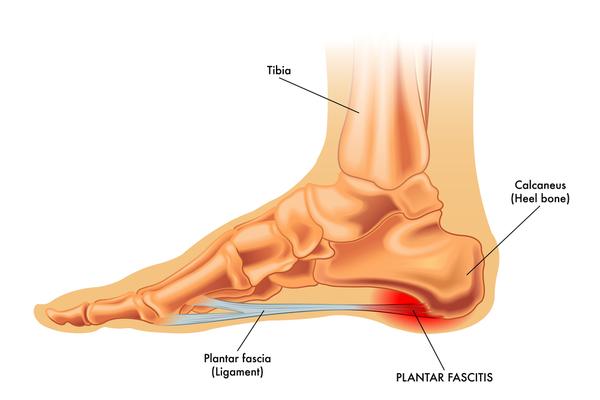Plantar Fasciitis

What are the reasons for plantar fasciitis?
There are many reasons for plantar fasciitis. Some common ones are
- Being overweight
- Runners who don’t spend enough time in stretching are at risk
- Wearing ill-fitting shoes, especially with thin insoles
- It tends to be commoner in middle aged people between 40 to 60 years of age
- People who spend long hours standing, like store attendants and teachers, are more prone to heel pain due to the extra stress on the tissues of the foot
- Sometimes, there can be an extra growth of bone from the heel bone, called a spur. This can also irritate the plantar fascia
- Some people have high arched feet or flat feet and these can also make them more prone to heel pain
How to know if you have plantar fasciitis?
- Generally, plantar fasciitis causes pain in the heel. The pain tends to be more in the mornings and gets better as the day goes by and the tissue of the foot gets stretched.
- There might be a tender spot on the heel.
What can be done at home for plantar fasciitis?
There are some measures that might help in dealing with the pain of plantar fasciitis at home itself
- Icing the heel a few times a day can reduce the inflammation in the area and reduce the pain.
- A pain relieving balm can also help in reducing the pain and inflammation. These typically contain menthol, camphor or even local pain relieving drugs, so it’s best to do a sensitivity test before using such products.
- Resting your foot and avoid strenuous weight bearing activities can also help.
- Heel pads and arch supports and changing to soft, padded shoes can also help in reducing heel pain.
When to meet the doctor?
- If the home remedies don’t help
- The pain is recurrent
- The pain is severe
- There is swelling of the foot
- There is discoloration of the foot
- There is any numbness of the feet
- The feet feel very cold
How is plantar fasciitis managed?
- The doctor might recommend some tests like an X ray or an MRI.
- Some blood tests to rule out other inflammatory diseases, like rheumatoid arthritis or gout, might also be recommended.
- Plantar fasciitis is general managed with anti-inflammatory drugs, like ibuprofen, to take care of the pain.
- Physical therapy is also an important part of the treatment, and this might involve ultrasonic massage, wax baths or ESWT (extra corporeal shock wave therapy) in which high energy shock waves are used to stimulate the healing process in the plantar fascia.
- Sometimes, there might be the need for local steroid injections to relieve the pain. This is an out patient procedure and will be performed by your doctor after checking the point of maximum tenderness.
- In severe cases, there might be the need for surgery which might involve lengthening the calf muscle or even detaching the plantar fascia from the heel if the pain is very severe.
How to prevent plantar fasciitis?
Some precautions can help in preventing repeated bouts of plantar fasciitis
- Wearing well-fitting shoes is important if you exercise regularly.
- It’s important to stretch the foot and calf tissues before beginning a workout session.
- Losing weight if you are overweight can help in reducing the stress on the tissues of the feet.
- Using arch or heel supports can also help in cushioning the tissues of the heel.
Mostly, plantar fasciitis resolves with rest and physical therapy. With some long term precautions, it generally doesn’t recur.
We advocate consulting a doctor before beginning any treatment regime.
Sources:
https://www.mayoclinic.org/diseases-conditions/plantar-fasciitis/
https://www.aafp.org/afp
https://orthoinfo.aaos.org/en/diseases–conditions/plantar-fasciitis


